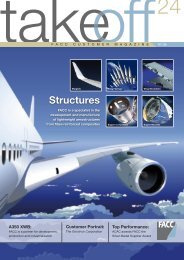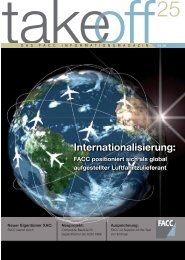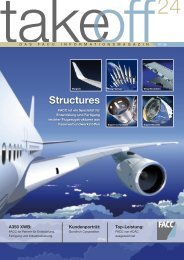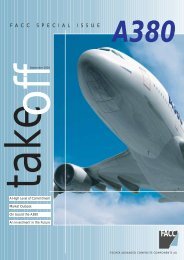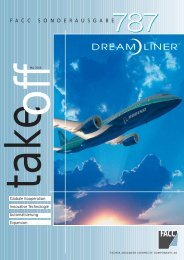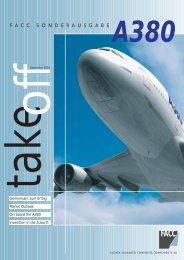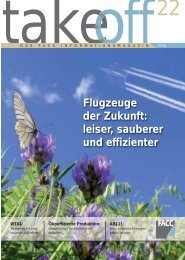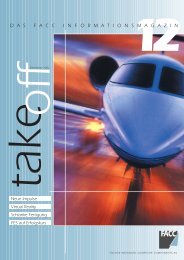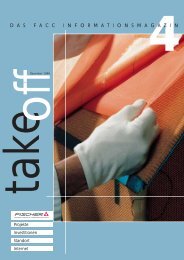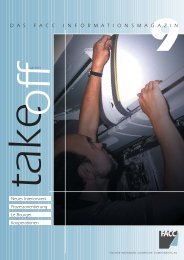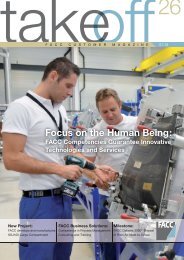"take off" - Issue 12 - FACC
"take off" - Issue 12 - FACC
"take off" - Issue 12 - FACC
Create successful ePaper yourself
Turn your PDF publications into a flip-book with our unique Google optimized e-Paper software.
<strong>12</strong><br />
F A C C C U S T O M E R M A G A Z I N E<br />
<strong>take</strong> off<br />
New Impulses<br />
Virtual Reality<br />
December 2002<br />
Lean Production<br />
The Success of FES<br />
<strong>FACC</strong><br />
FISCHER ADVANCED COMPOSITE COMPONENTS AG
F A C C C U S T O M E R M A G A Z I N E<br />
Dear readers,<br />
The catch phrase is Virtual Reality: man and machine<br />
entering a new form of interaction. Three-dimensional<br />
graphics from a computer transplant humans<br />
into an artificial reality. In the future, immersing into<br />
virtual worlds, expanding reality with inserted information,<br />
and experiencing products that do not yet<br />
actually exist will be standard for many people on<br />
and off the job. <strong>FACC</strong> is also innovatively applying<br />
this key technology. <strong>FACC</strong> engineers and technicians,<br />
in cooperation with designers from Ars Electronica<br />
Futrelab, have designed a digital mock-up of a<br />
passenger cabin. This new visualizing and simulation<br />
technology opens new doors. Plunge with us into a<br />
three-dimensional world!<br />
Bombardier Aerospace has long since moved on<br />
past the Virtual Reality stage in the development of<br />
their two new business jets Learjet 40 and Learjet<br />
45XR: the first of both planes will already be<br />
delivered to customers in 2003 and 2004. This<br />
Canadian aircraft manufacturer has chosen <strong>FACC</strong><br />
for the production of the interiors for both series.<br />
A company's long-term success is to a great extent<br />
based on its courage to make changes and its<br />
willingness to be progressive. Why? We are living in<br />
a time of far-reaching changes - changes that are<br />
possibly even more radical than those of the<br />
second industrial revolution of the mid-19th century.<br />
In order to keep pace with this situation, a company<br />
must constantly renew itself and continue developing.<br />
At the same time, structures must be established<br />
that assure the continual and long-term successful<br />
development of the company. <strong>take</strong> off would like to<br />
present two of many excellent measures that <strong>FACC</strong><br />
has <strong>take</strong>n to assure its success:<br />
1) "fleXman", a lean manufacturing system, and<br />
2) the future-oriented restructuring in our development<br />
division.<br />
On the following pages you will find further<br />
interesting topics about <strong>FACC</strong>. We hope you enjoy<br />
this issue of <strong>take</strong> off and gain insight into the<br />
workings and changes of our company.<br />
Manfred Neuböck / Andrea Schachinger<br />
Editors<br />
Cover: Bombardier Learjet 40<br />
<strong>take</strong>off2<br />
<strong>take</strong><br />
off<br />
Contents:<br />
New Impulses 3<br />
New Standards<br />
in the Development of<br />
Aircraft Passenger Cabins<br />
Modern Design Application by Means of Virtual Reality 4<br />
Cabin Interior Liners 6<br />
6<br />
The future<br />
is on the wing<br />
New Winglets For Boeing Aircraft 8<br />
Steps Towards Lean Production 10<br />
"A Pike<br />
in a Fishpond"<br />
<strong>FACC</strong>’s Development Design Office Is Continuing On Its Road To Success <strong>12</strong><br />
Fan Cowls For Gulfstream GIV 14<br />
Christkindl near Steyr<br />
Austria´s Christmas post office 15<br />
Published by: FISCHER ADVANCED COMPOSITE COMPONENTS AG, Fischerstraße 9, A-4910<br />
Ried/Austria. Editorial Staff: (verantwortlich) Manfred Neuböck, Walter Stephan, Andrea<br />
Schachinger. Photos: <strong>FACC</strong> Ried, AEC Linz, Bombardier Montreal, APB Seattle, Österreichische<br />
Post Wien, Furtner Ried. Design and Composition: Oskar Pointecker, 4941 Mehrnbach.
F A C C C U S T O M E R M A G A Z I N E<br />
New Impulses -<br />
New Chances<br />
The overall economic situation is still rough<br />
for many companies, especially for those in<br />
the aviation industry. The year 2002 will<br />
show a lower growth rate than had been<br />
expected, and for 2003 the economic forecast<br />
does not promise the significant growth<br />
that would be needed to ease this tense<br />
situation on a long-term basis.<br />
The civil aviation industry is being influenced<br />
by the declining financial situation of some<br />
leading airlines, above all in the USA. Even<br />
the slight recovery of the Asian and<br />
European markets could not spare the civil<br />
aviation industry from a lasting slump. The<br />
two large airplane manufacturers EADS and<br />
Boeing record a continuing slack in demand<br />
for new airplanes and expect the situation<br />
to last through 2003 and 2004. The<br />
European company EADS is even describing<br />
the branch´s situation as a "double-dip<br />
recession" - a relapse into a recession after<br />
a short period of recovery.<br />
Due to new elections, Austria has delayed<br />
the decision whether to purchase Eurofighter<br />
jets or not. This was yet another negative<br />
effect on the Austrian aviation industry.<br />
However, a difficult market situation can<br />
also bring new impulses and new chances<br />
for <strong>FACC</strong>. We must seize the opportunity<br />
and turn them into new advantages.<br />
I would like to mention one of our most<br />
recent projects: the development and production<br />
of the outer bypass ducts for our<br />
new customer Pratt & Whitney. <strong>FACC</strong> was<br />
able to develop the product in record time<br />
and produce a prototype that offers the<br />
customer an excellent price-performance<br />
ratio. <strong>FACC</strong>´s development team worked<br />
with competence and commitment to<br />
develop a new innovative material for engine<br />
components of this kind. By using this<br />
material and improved processes,<br />
significant cost cutting could be achieved,<br />
along with improved products.<br />
The industry needs initiatives such as these<br />
in order to make the few deals profitable<br />
that our customers Airbus and Boeing mostly<br />
close with low-cost airlines such as<br />
Southwest, easyJet and Ryanair.<br />
In recent months <strong>FACC</strong> has delivered the<br />
first components from other new projects.<br />
These include the winglets for Boeing 737,<br />
fan cowls for the Gulfstream GIV, components<br />
for A380's Trent 900 engine, new secure<br />
cockpit doors for the B717, as well as the<br />
first interiors for the Learjet models 45XR<br />
and 40. (You can read more about these<br />
projects in the other articles.) These are<br />
projects which go into serial production on<br />
short notice soon after the placement of an<br />
order and generate a quick and secure cash<br />
flow during the production period. This is<br />
the necessary financial basis for long-term<br />
development projects, such as the widebody<br />
jet A380.<br />
Innovations from the think-tank of <strong>FACC</strong><br />
can be found in every new component.<br />
Advanced resin transfer molding, with which<br />
we can build spoilers that are 30% lighter<br />
than those made of conventional construction,<br />
as well as new light and intelligent overhead<br />
stowage compartments, are only two of the<br />
many good design solutions. The innovations<br />
are, however, not only of a technical nature,<br />
but are also concerned with extending<br />
logistics and expanding service for our<br />
customers.<br />
In the coming years <strong>FACC</strong> will meet the<br />
pressures of the market with considerable<br />
investments. These will be investments in<br />
new developments and, above all, in the<br />
people who work at <strong>FACC</strong> who commit<br />
themselves to meet the requirements<br />
during hard times and invest their excellent<br />
performance in the future of <strong>FACC</strong>, and, at<br />
the same time, in their own futures.<br />
This success can only be achieved, however,<br />
in close cooperation with our business<br />
partners. Our suppliers are an important<br />
support and their investments are imperative<br />
in order for us to follow the path of<br />
progress. On the other hand, our customers<br />
can support us with their strategic<br />
investments and further give us their hotlycontested<br />
orders, independent of shortterm<br />
political decisions in the current phase<br />
of the market.<br />
This way they can strengthen our financial<br />
power so that we can participate as a<br />
competent partner in major development<br />
programs of the future.<br />
With these efforts, we hope to be one<br />
of the leading companies in our<br />
industry, today as well as at the point<br />
in time when the industry will again<br />
pick up the rapid growth rate it had<br />
been used to. Let us jointly make the<br />
best of these impulses!<br />
Walter A. Stephan<br />
Chairman of the Board<br />
3 <strong>take</strong>off
F A C C C U S T O M E R M A G A Z I N E<br />
New Standards in the<br />
Development of<br />
Aircraft Passenger Cabins<br />
Virtual Reality in Modern Design Application<br />
Whether a modern passenger aircraft will find acceptance among travelers is largely<br />
determined by passenger comfort and cabin design. In order to provide a pleasant flight<br />
and maximum passenger comfort, aircraft manufacturers and airlines offer the passenger<br />
future-oriented design with comfortable equipment. At the same time they want the<br />
cabin interior to reflect their corporate design.<br />
The basis for a successful cabin design are<br />
often already put in the first development<br />
stages of the cabin. A visually well and<br />
close-to-reality prepared design model is<br />
crucial. As a systems provider of cabin interiors<br />
for civil aircraft <strong>FACC</strong> goes a new way in the<br />
visualization of design concepts and works<br />
in co-operation with iDS Industrial Design<br />
Studio Hamburg and Ars Electronica<br />
Futurelab on implementing new futureoriented<br />
design solutions and their application:<br />
Virtual Reality is thereby the medium of the<br />
future.<br />
As an excellent tool to visualize design<br />
concepts, in particular for product presentation<br />
and to help the customers make fast<br />
decisions, <strong>FACC</strong> will more and more use<br />
Virtual Reality applications. New technologies,<br />
materials, procedures and production<br />
methods can be constantly integrated from<br />
the very first idea to the actual market<br />
launch and be presented the customers<br />
over the medium Virtual Reality. It will help<br />
to respond more flexibly to changing<br />
customer expectations and to substantially<br />
accelerate and qualitatively improve the<br />
development process. At the same time the<br />
visualization of digital cabin models by<br />
means of Virtual Reality allows in some<br />
cases to eliminate the physical models that<br />
have been used in the past, obtaining<br />
significant time and cost savings.<br />
<strong>take</strong>off4<br />
What is Virtual Reality?<br />
Creating three-dimensional objects and<br />
presenting them in perspective and as close<br />
to reality as possible in the form of flat<br />
pictures often fails to convey the impression<br />
of space, essential with spatial objects and<br />
in interior design in particular. Two-dimensional<br />
pictures may at best succeed in demonstrating<br />
to the beholder the overall spatial impression<br />
but not in reproducing it.<br />
Virtual Reality (VR) is the three-dimensional<br />
spatial presentation of design concepts or<br />
product developments through computer<br />
simulations. In order to be used in a VR<br />
system the CAD data first need to be<br />
adapted: invisible elements are removed<br />
and free form areas in VR Tool are converted<br />
to triangles. As a next step, colors, decor,<br />
textures and transparent effects are defined<br />
together with light effects (intensity, hues).<br />
This virtual mock-up is very flexible. In no<br />
time one can change coverings, surfaces,<br />
textures and colors or try out variations in<br />
details like handrails, for example.<br />
A Team of Specialists<br />
Provides the Real Feel of<br />
an Aircraft Cabin<br />
Virtual Reality application is made possible<br />
through the conjunction of a number of<br />
competency centers: <strong>FACC</strong> represents<br />
engineering skills and the production knowhow,<br />
iDS industrial Design Studio Hamburg<br />
provides industrial design and the Ars<br />
Electronica Futurelab supplies the transfer<br />
competency that converts the concept and<br />
design results into virtual data as the basis<br />
for their application.<br />
iDS Industrial Design Studio Hamburg<br />
has been working in the passenger cabin<br />
field since 1984 (e.g. the B717, the Fairchild<br />
Dornier 728/928, VIP and Corporate<br />
Aircraft). iDS has developed design<br />
concepts for all transportation systems. One<br />
of their projects done in cooperation with<br />
<strong>FACC</strong> was the development of the Boeing<br />
717 cabin interior. The company operates<br />
world-wide and focuses on innovative<br />
marketable product concepts that are<br />
geared to the future. Its sophisticated concept<br />
renderings, 3-D concept presentations and<br />
the experimental 1:1 mock up facilitates<br />
instant well-founded decisions.
F A C C C U S T O M E R M A G A Z I N E<br />
One of the key competencies of Ars<br />
Electronica Futurelab lies in the creation<br />
of new interfaces for Virtual Reality and<br />
Augmented Reality as well as in the specific<br />
conception and realization of applications.<br />
The Virtual Reality ARS BOX as designed by<br />
Ars Electronica Futurelab facilitates the<br />
stereoscopic projection of digital models<br />
in their actual size and their adequate<br />
rendition in a real time frame.<br />
Ever since its founding, Ars Electronica<br />
Futurelab and its team of physicists, data<br />
processing engineers, artists and designers<br />
have acquired the necessary transfer competency,<br />
i.e. making the actual application<br />
work, through international projects. One of<br />
their long-standing partners is the Electronic<br />
Visualisation Laboratory at the University of<br />
Illinois, where CAVE technology was originally<br />
invented and developed.<br />
Their<br />
partners in the<br />
automotive industry ( e.g. PSA<br />
Peugeot/Citreon), the IT sector (e.g.<br />
Siemens CT SE), heavy industries (e.g.<br />
VA Industrial Plants), the research field<br />
(NASA, Langley Research Center) and now<br />
the aircraft industry (<strong>FACC</strong>) are all vivid<br />
proof that technology and aesthetics<br />
need not necessarily be opposites.<br />
The cooperation goes to show once again<br />
that questions concerning the future at the<br />
vertex of art, technology and society require<br />
innovative solutions and that this team<br />
makes it possible to <strong>take</strong> a peek at the future<br />
of aircraft construction.<br />
Virtual Reality<br />
in all Phases<br />
Virtual Reality stands therefore not only at a<br />
specific stage of the product development<br />
process, but is employed in the early<br />
phases of the development in order to<br />
support styling decisions as well as during<br />
the whole development chain to document<br />
intermediary steps or alternative design<br />
concepts. Great emphasis is placed on a<br />
high<br />
degree of detail<br />
reproduction. This way it becomes<br />
possible to check the position and transition<br />
of seams between the individual<br />
components and to assess the quality of<br />
surface areas. In complex systems virtual<br />
prototyping allows for the swift modification<br />
of structures and processes and<br />
consequently helps to greatly reduce the<br />
number of potential design changes,<br />
construction errors and revamping times.<br />
All analyses and tests can be carried out in<br />
the form of a digital mock-up (dmu), which<br />
dramatically shortens development times.<br />
Once again the focus is on real time<br />
applications, which are used in the design<br />
process as well as for presentation purposes.<br />
5<br />
<strong>take</strong>off
F A C C C U S T O M E R M A G A Z I N E<br />
The first contacts between Bombardier Aerospace, the world’s third largest aircraft<br />
manufacturer, and <strong>FACC</strong> date back to 1987, and now the two companies are expanding<br />
their partnership. Under a new agreement, <strong>FACC</strong> is to produce cabin interior components<br />
for the new Bombardier Learjet 40 and Learjet 45XR light business jets, launched at the<br />
Farnborough International Air Show last July.<br />
In September 2002, Bombardier and <strong>FACC</strong><br />
signed a contract for the production of cabin<br />
interior liners for the Learjet 40 and 45XR.<br />
The first components were already delivered<br />
in October 2002.<br />
Bombardier Aerospace, a unit of<br />
Bombardier Inc., is a world leader in the<br />
design, and manufacture of innovative aviation<br />
products and services for the regional,<br />
business and amphibious aircraft markets.<br />
Headquartered in Montreal, Canada,<br />
Bombardier Aerospace employs approximately<br />
33,000 people around the globe,<br />
including its manufacturing facilities in<br />
Canada, the United States, and the United<br />
Kingdom.<br />
The Bombardier line of business jet is<br />
divided into three families. The high<br />
<strong>take</strong>off<br />
Cabin Interior Liners<br />
Bombardier Learjet 40 & 45XR<br />
6<br />
performance Learjet group consists of the<br />
Learjet 40, the Learjet 45, the Learjet 45XR<br />
and the Learjet 60. In the large jet category,<br />
Bombardier offers the Challenger family,<br />
comprised of the all-new Challenger 300,<br />
the Challenger 604 and the Challenger<br />
800. The Global family is led by the ultra<br />
long-range Global Express, and the new,<br />
high-speed intercontinental Global 5000.<br />
The New Generation<br />
Of Learjets – Superior<br />
Performance<br />
The Learjet 40 and Learjet 45XR, the two<br />
short-range business jets that Bombardier<br />
presented for the first time at the<br />
Farnborough Air International Air Show, will<br />
complement the successful Learjet family.<br />
The Learjet 40 is a new aircraft that, with a<br />
maximum speed of 859 km/h and an operating<br />
altitude of 15,545 meters, flies further, faster<br />
and higher than comparable business jets.<br />
The first Learjet 40 will be delivered in early<br />
2004. The Learjet 45XR is an extended<br />
version of the Learjet 45 and offers<br />
improvements in flight speed and operating<br />
altitude as well as a new larger interior with<br />
optimized comfort for the passengers.<br />
Specifications Bombardier Learjet 40 Bombardier Learjet 45XR<br />
Capacity Passengers: Up to 7 Passengers: Up to 9<br />
Crew: 2 Crew: 2<br />
Maximum range 1,803 nm, 3,339 km 2,098 nm, 3,885km<br />
(IFR Reserves, ISA, with 4 pax/2 crew)<br />
The Learjet Legend Lives On<br />
Maximum speed 0.81 Mach, 534 mph, 859 km/h 0.81 Mach, 534 mph, 859 km/h<br />
Maximum operating altitude 51,000 ft, 15,545 m 51,000 ft, 15,545 m<br />
Cabin length 17.7 ft, 5.40 m 19.75 ft, 6.02 m<br />
Cabin width 5.<strong>12</strong> ft, 1.56 m 5.<strong>12</strong> ft, 1.56 m<br />
Cabin height 4.92 ft, 1.50 m 4.92 ft, 1.50 m<br />
Cabin volume 363 ft 3 ., 10.28 m 3 410 ft 3 , 11.61 m 3
F A C C C U S T O M E R M A G A Z I N E<br />
New Improvements<br />
In Cabin Layout<br />
Under the new agreement, <strong>FACC</strong> produces<br />
the interior linings for the entire cabin<br />
which includes sidewall panels, window<br />
components, arm rest coverings, PSU<br />
panels, ceiling panels, cargo hold panels<br />
and cockpit doors, as well as all panels in<br />
the lavatories. The interior will be completely<br />
produced by <strong>FACC</strong> and delivered to the<br />
Bombardier Aerospace Completion Center<br />
in Tucson, Arizona, for integration into the<br />
aircraft fuselage.<br />
The components are made of fiberglass in a<br />
sandwich construction, and customers will<br />
be able to choose from different materials<br />
for the interior.<br />
The new interior lining of the Bombardier<br />
Learjet incorporates modern design lines<br />
with ergonomic cabin elements and offers<br />
the passengers maximum comfort. Open<br />
and soft surfaces with sophisticated lighting<br />
and functional details are characteristic. The<br />
cabin lighting sets new benchmarks and is<br />
cleverly integrated into the cabin layout.<br />
Savings Through<br />
Automated Production<br />
Bombardier and <strong>FACC</strong> intend to integrate<br />
automated production technologies. Where<br />
in the past the processing and<br />
assembly of the components was<br />
exclusively done manually, an<br />
automated production and as a<br />
consequence a substantially<br />
more efficient assembly will be<br />
implemented using CAD/CAM<br />
(CATIA), offering the potential of<br />
significant cost savings for aircraft<br />
interior producers.<br />
<strong>FACC</strong> carried out the integration of<br />
the new interiors in extremely<br />
short time, starting Learjet 45XR<br />
interior deliveries in October<br />
2002. The first deliveries for<br />
interiors of the Learjet 40 will<br />
<strong>take</strong> place shortly. For this aircraft,<br />
the focus has been on optimizing<br />
the fitting between the fuselage<br />
and the interior, which should<br />
produce a minimal gap between<br />
the panels. This should eliminate<br />
the need for prework during the<br />
aircraft assembly. During this phase of the<br />
project, close cooperation between<br />
Bombardier’s Belfast facility, where the<br />
fuselage is manufactured, Bombardier’s<br />
Tucson completion center, and <strong>FACC</strong> will<br />
<strong>take</strong> place. Bombardier and <strong>FACC</strong> employees<br />
will work together in Tucson, Arizona on<br />
analyzing, optimizing and putting the<br />
concept into action.<br />
This new contract marks <strong>FACC</strong>´s entrance<br />
into the market segment for interiors for<br />
business jets. By implementing its well-known<br />
strengths - extensive engineering competence<br />
and modern production technologies -<br />
<strong>FACC</strong> intends to continually expand into this<br />
market segment.<br />
7 <strong>take</strong>off
F A C C C U S T O M E R M A G A Z I N E<br />
The Future Is On The Wing:<br />
New Winglets For Boeing Aircraft<br />
Aviation Partner Boeing, a small American company located in Seattle, has developed a new<br />
winglet technology that promises significant performance advantages. The B737 aircraft<br />
and all Boeing Business Jets will be fitted with the Blended Winglets. <strong>FACC</strong> has been<br />
chosen to manufacture these new wingtips.<br />
At the Farnborough Airshow Aviation<br />
Partners Boeing and <strong>FACC</strong> signed a contract<br />
for the manufacture of the new Blended<br />
Winglets for Boeing airplanes. <strong>FACC</strong> is<br />
responsible for the manufacture of the<br />
composite winglets for the new generation<br />
of B737 aircraft, the B737-700 and B737-800<br />
and for all Boeing Business Jets. The<br />
contract is worth approx. 17 mil. US$ to <strong>FACC</strong>.<br />
<strong>FACC</strong> will deliver the first new Blended<br />
Winglets in December 2002, either to<br />
Aviation Partners Boeing in Seattle for<br />
installation in a new Boeing aircraft or directly<br />
to the airline customer for retrofit in existing<br />
in-service B737-700 or -800.<br />
Aviation Partners Boeing (APB), a joint-venture<br />
company of The Boeing Co. and Aviation<br />
Partners Inc. located at Seattle, is a new<br />
customer of <strong>FACC</strong>. The company is responsible<br />
for developing and marketing the new<br />
Blended Winglet Technology for Boeing<br />
Commercial Aircraft.<br />
<strong>take</strong>off<br />
8<br />
Using Nature as a Model:<br />
New Blended Winglet<br />
Technology<br />
By developing the new Blended Winglet<br />
Technology, Aviation Partners Boeing has<br />
brought a product on the market that not<br />
only revolutionizes aerodynamic performance<br />
and saves fuel, but also <strong>take</strong>s a giant step<br />
towards eco-friendliness.<br />
Winglets, shaped in the form of a bird´s<br />
wing, are components which are mounted<br />
on the wingtips and thus lengthen the wings.<br />
As opposed to the conventional winglets<br />
that stand at a sharp angle to the wing, the<br />
new Blended Winglets gently curve up, as if<br />
they were part of the wing.<br />
Through this new technology, air vortex at<br />
the wingtips and drag are sharply reduced,<br />
producing higher aerodynamic efficiency,<br />
which in turn means lower operating costs.<br />
For a B737-800, fuel consumption is reduced<br />
by about 5%, which amounts to several<br />
hundred tons of fuel per aircraft per year.
F A C C C U S T O M E R M A G A Z I N E<br />
The reduced carbon<br />
dioxide emissions - 1,900 tons<br />
less per aircraft per year - make<br />
this technology not only<br />
economically but also environmentally<br />
advantageous.<br />
Airplanes that are fitted with Blended<br />
Winglets fly higher and further than planes<br />
with conventional wingtips. A B737-800 has<br />
an increased range of about 300 kilometers<br />
and can reach an approximately 600 meter<br />
higher cruising altitude.<br />
In addition, <strong>take</strong>off performance is greatly<br />
improved. The winglets allow for a steeper<br />
climb<br />
a n d<br />
reduced<br />
runway time<br />
and this shortened<br />
<strong>take</strong>off phase<br />
results in a significantly<br />
lowered noise level<br />
during this stage.<br />
Until now larger passenger planes could<br />
either not land at all at smaller airports, or<br />
only with a limited number of passengers.<br />
In the future, a B737-800 that is fitted with<br />
Blended Winglets will be able to <strong>take</strong> off<br />
and land at smaller airports (e.g. on small<br />
Greek islands).<br />
Efficient Production thanks<br />
to New Processes<br />
<strong>FACC</strong> is responsible for the production of<br />
the composite components, as well as the<br />
assembly of the complete winglets and the<br />
installation of diverse lights. For this, highquality<br />
components of titanium, aluminum<br />
and similar<br />
materials are<br />
used.<br />
The individual prepreg<br />
layers and cores of the<br />
sophisticated composite skins<br />
are positioned on the tool surface<br />
by using laser technology, for which<br />
modern laser projection systems have<br />
been specially procured. This high-precision<br />
equipment allows for improved efficiency in<br />
production as well as improved accuracy in<br />
positioning.<br />
A new way was hit also in the material<br />
procurement of standard parts: in this context<br />
the production of winglets is a pilot project<br />
for the initial application of the Kanban process<br />
for component-related material at <strong>FACC</strong>.<br />
This new process brings with it, among<br />
other advantages, a considerable reduction<br />
of stock and a marked simplification of the<br />
procurement process. For the new Kanban<br />
process, keeping the bins for the needed<br />
standard parts filled is the responsibility of<br />
the supplier. By using a barcode reader<br />
directly at the bins, an <strong>FACC</strong> employee sees<br />
what supplies are required and orders online<br />
from the central store of the supplier. The<br />
supplies can then be delivered just-in-time.<br />
To the maintenance of stock only the given<br />
lot size of standard parts lies in stock.<br />
Intensive Cooperation<br />
between APB and <strong>FACC</strong><br />
Beyond the production of new winglets for<br />
the Business Jets and B737s, a more<br />
intensive cooperation with APB is a possibility<br />
for <strong>FACC</strong>, in the form of manufacturing<br />
advanced winglets for other Boeing aircraft<br />
as well. In this co-operation <strong>FACC</strong> can bring<br />
in the constantly obtained experiences from<br />
the current project as well as their extensive<br />
knowledge with the development and<br />
manufacturing of other high-quality composite<br />
components for aircraft wings and support<br />
APB in the best way during their demand<br />
after best aerodynamics and flight<br />
performance during smallest environmental<br />
impact.<br />
9 <strong>take</strong>off
F A C C C U S T O M E R M A G A Z I N E<br />
When the Interiors Facility in Ort was opened<br />
in the summer of 2000, management<br />
decided to implement measures relating to<br />
the concept of lean production. Under the<br />
leadership of Fritz Hofwartner, production<br />
expert at <strong>FACC</strong> and General Manager, the<br />
Interiors team has since then successfully<br />
implemented a number of lean manufacturing<br />
concepts. The system of "drumbeat<br />
manufacturing” developed thereby<br />
supplied best results in practice and represents<br />
the basis for the introduction of lean manufacturing<br />
in the entire production area of<br />
<strong>FACC</strong>.<br />
Following an extreme growth period in the<br />
Structures plant in Ried it was decided in<br />
summer 2001 to examine the introduction<br />
of lean manufacturing in the context of a<br />
dissertation. "Fixed Leading Edges Boeing<br />
777" was chosen as the pilot project with<br />
the objective of developing and implementing<br />
a concept within the six months allocated<br />
for the dissertation, with the goal of<br />
achieving sustainable improvements in the<br />
following areas:<br />
● reduction of work in progress and<br />
finished goods<br />
● reduction of production cycle time and<br />
waiting time<br />
● increase of productivity<br />
● increased transparency in manufacturing<br />
● simplification of production planning<br />
and -monitoring<br />
● planning of equipment utilisation<br />
● quality and non conformities<br />
● swift reaction to deviations in the<br />
production flow.<br />
The improvements were to be achieved primarily<br />
through the usage of the "lean production"<br />
tools, the objectives of which can<br />
best be illustrated through the following<br />
terms:<br />
<strong>take</strong>off10<br />
Steps<br />
Towards Lean Production<br />
Consolidation offers a chance to introduce substantial and sustainable improvements in<br />
the production process. Implementation and results of Daniel Gattinger´s practice<br />
oriented dissertation.<br />
5 Zeros<br />
● zero paper (not 100% computerization<br />
but simple and clear procedures)<br />
● zero stock (minimal batch sizes and<br />
amounts of stock)<br />
● zero breakdown time<br />
● zero scrap<br />
● zero waiting time<br />
Avoiding 7 types<br />
of waste<br />
● waste by overproduction<br />
● waste by waiting time<br />
● waste by transport<br />
● waste by the production process<br />
● waste by large inventory<br />
● waste by motion<br />
● waste by faulty manufacturing<br />
The fleXman logo, for flexible manufacture<br />
was created as the central term for the<br />
project and to generate its own Corporate<br />
Identity.<br />
In the course of a situation analysis of the<br />
status quo, the parts spectrum and the<br />
ordering practice of the customer, it became<br />
clear that the solution should be found in a<br />
a special type of serial production. As opposed<br />
to serial production in the automotive<br />
industry, the aircraft manufacturing industry<br />
needs to operate with the actual batch size 1,<br />
due to very small quantities. The complexity<br />
of the parts spectrum in the pilot project<br />
called for a specific solution to achieve the<br />
objectives:<br />
● 4 configurations with 7 product groups,<br />
each ordered in non-cycling intervals<br />
● consisting of a total of 167 single parts<br />
of different dimensions and shapes<br />
● 2 different autoclave cycles within the<br />
product groups.<br />
The considerations led to a system of fixedcycle<br />
production with a daily output linked<br />
to customer needs and a "pull system”<br />
from production step to production step in<br />
a timed cycle similar to a timetable. The<br />
"pull-system" should be steered by customer<br />
order requirements. The daily production<br />
varies in geometry and quantity depending<br />
on customer orders, respectively parameters<br />
mandated by production like efficient<br />
use of facilities and human resources.<br />
Starting from specific product and customer<br />
requirements, the system was developed in<br />
ten detailed steps.<br />
How does<br />
fleXman work?<br />
Production planning puts together clearly<br />
defined daily output packages based on the<br />
ordered product groups. The result is a clear<br />
production plan for that particular day as<br />
well as the scheduling of the necessary<br />
autoclave programs.<br />
After curing and debagging, the components<br />
manufactured in the cleanroom are<br />
placed on a special trolley (called KANBAN<br />
at <strong>FACC</strong>) and cycled through the production<br />
steps. This cycle is pre-defined with fixed<br />
time windows and hand-over points. A clear<br />
illustration of the procedure on each<br />
KANBAN and additional control signals<br />
provide an exact and well-defined process.<br />
Additionally, the data of all components can<br />
be traced in the ERP system, which offers a<br />
significant advantage to the fine-tuning of<br />
personnel and production planning, especially<br />
since all facilities are also used for the<br />
manufacture of other products.
F A C C C U S T O M E R M A G A Z I N E<br />
In April of 2002, production switched over<br />
to the new system and instantly achieved a<br />
stable production routine. One of the<br />
success factors was the integration of<br />
responsible production employees already<br />
at the stage of concept development and<br />
thus the position to eliminate potential problem<br />
areas right there and then, e.g. during<br />
the coordination meetings fixed production<br />
windows for jointly-used facilities were<br />
defined or training programs for cleanroom<br />
workers were set up to enable them to<br />
produce any component of the product<br />
range at any time.<br />
Results (after 7 months)<br />
GOAL START ACT. DIF.<br />
Production cycle time (working days) 6 19 6 68%<br />
Internal delivery performance<br />
(finished to plan date)<br />
100% 4% 96% 92%<br />
Customer delivery performance 100%<br />
(delivery to plan date)<br />
80% 100% 20%<br />
WIP/monthly turnover 30% 44% 14% 68%<br />
Productivity (average<br />
without process changes)<br />
100% 80% 108% 28%<br />
➔ ➔<br />
➔ ➔ ➔<br />
After seven months of field application, the<br />
results clearly show that the objectives have<br />
been achieved. As a side effect, apart from<br />
cutting costs there is a very high degree of<br />
satisfaction among employees due to the<br />
fact that the transparency of the daily routine<br />
leaves room for quick reactions to disturbances<br />
and allows for continous improvements.<br />
"Tying in my college studies of mechatronics<br />
and business plus elective production<br />
technique at the "Fachhochschule<br />
Wels” with my job yielded essential<br />
impulses for the design of the lean production<br />
line. My dissertation did not<br />
merely aim to be a theoretical study of a<br />
production-related project but also the<br />
practical application of the ideas at <strong>FACC</strong>.<br />
Based on the practical experience with<br />
lean production gathered beforehand at<br />
the <strong>FACC</strong> facility in Ort and thanks to the<br />
support given by the team around<br />
Friedrich Hofwartner the project turned<br />
out very sucessfully. One priority in my<br />
new area of responsibility at the Ort facility<br />
will be the further enhancement and<br />
qualitative fine-tuning of lean production<br />
methods."<br />
Daniel Gattinger<br />
Designate General Manager<br />
Interiors<br />
Both of <strong>FACC</strong>'s general<br />
managers are exceptionally<br />
satisfied with the<br />
results of the pilot project.<br />
The next step is the<br />
implementation in all<br />
areas in both facilities.<br />
"When we undertook the first steps<br />
towards lean production in the fall of<br />
2000 it became obvious that the<br />
employees involved in the process<br />
definitely welcomed the method because<br />
of its clear structure of both the targets<br />
and the processes of the individual production<br />
steps. This observation and the<br />
fact that massive savings and a high<br />
degree of efficiency could be achieved<br />
have become the driver in our intention<br />
to switch over to lean production in the<br />
entire production area at the <strong>FACC</strong><br />
Structures facility in Ried."<br />
Friedrich Hofwartner<br />
General Manager Structures<br />
11 <strong>take</strong>off
F A C C C U S T O M E R M A G A Z I N E<br />
<strong>take</strong>off<br />
"A Pike in a Fishpond"<br />
<strong>FACC</strong>’s Development Design Office Is Continuing<br />
On Its Road To Success<br />
<strong>FACC</strong> has not regretted its decision: creating <strong>FACC</strong> Engineering Solutions, a small<br />
but effective development and design engineering team, which started up in<br />
May 2001 with offices in Ried and Vienna, has been praised as a technological<br />
spearhead in the hotly contested aviation market. The present expansion of the<br />
team confirms its success.<br />
CUSTOMER<br />
When the decision was made in October<br />
2000 to found "<strong>FACC</strong> Engineering<br />
Solutions", or FES, no one could have<br />
foreseen its rapid development and the great<br />
significance it would have for the company as<br />
a whole. The decision went hand in hand<br />
with an organizational restructuring in the<br />
company and the creation of two new<br />
divisions, the Interiors and the Structures<br />
Divisions.<br />
The central idea in founding FES as<br />
<strong>FACC</strong>´s central development division,<br />
was to concentrate the engineering knowhow<br />
and to co-ordinate practical experience<br />
from within the company to provide custommade<br />
development concepts for both divisions.<br />
Since then, FES has developed into an<br />
indispensable element of <strong>FACC</strong>'s technological<br />
competence marketing. It has been a<br />
major force in landing new development<br />
contracts in spite of the turbulent times the<br />
aviation industry is going through.<br />
Hermann Filsegger, Director of Engineering<br />
and head of FES, has this to say: "What<br />
sets FES significantly apart from the<br />
other engineering teams has been<br />
repeatedly confirmed by our customers<br />
themselves: a high degree of commitment<br />
coupled with great flexibility, dedication to<br />
the projects and a willingness to question,<br />
change and further improve seemingly<br />
adequate things. Besides, it is fun to be a<br />
pike in the fishpond."<br />
<strong>12</strong> 6<br />
<strong>FACC</strong> Structures <strong>FACC</strong> Interiors<br />
Providing technically and economically<br />
mature concepts as answers to the problems<br />
of our aviation customers guarantees<br />
<strong>FACC</strong> an aggressive market entry and access<br />
position, and supports <strong>FACC</strong>´s strategy of<br />
proving itself as a "Supply Chain Partner" for<br />
aircraft and engine manufacturers.<br />
Trade studies relate design and production<br />
concepts to economic conditions to achieve<br />
the perfect balance between design and<br />
affordability. They are imperative nowadays<br />
for the acquisition phase of complex aircraft<br />
structures. In addition to setting up numerous<br />
technical trade studies, the FES designers<br />
and stress engineers work together with<br />
<strong>FACC</strong>´s own R&D team, and are in charge of<br />
FES<br />
"<strong>FACC</strong> Engineering Solutions"<br />
<strong>FACC</strong> development projects for both the<br />
Interior and Structures Divisions, from initial<br />
design all the way up to serial production.<br />
So its only logical that FES leaves its mark<br />
right at the customer's location all over the<br />
world. Not only is FES active in the bidding<br />
phase as technical support for our sales<br />
divisions, but provides technical support as<br />
well during "co-location" or "joint definition"<br />
phases directly at our customers´ locations -<br />
sometimes for months at a time - in order<br />
to coordinate the first development ideas<br />
and concepts with the customers.
F A C C C U S T O M E R M A G A Z I N E<br />
The following are some successful<br />
examples from the current year that<br />
briefly outline the tasks of FES:<br />
● Technical support of sales activities of<br />
both divisions<br />
● Conceptual design of wing spoilers for<br />
Airbus A380<br />
● Conceptual design of flap tracks for<br />
Airbus A380<br />
● Concept study of the Canard (complete<br />
horizontal stabilizer) for Boeing’s Sonic<br />
Cruiser<br />
● Conceptual design of light, integral<br />
Vertical Tail Plane Ribs for Airbus A380<br />
● Development of flap track fairings for<br />
Airbus A380<br />
● Development of Engine Inlet Barrels<br />
for RR TRENT 900 and GP 7200<br />
(Airbus A380 engines)<br />
● Development of rotating RTM components<br />
in an Rolls Royce engine<br />
● Conceptual design of a kinematicsystem<br />
of overhead bins for Airbus<br />
A380 interiors<br />
● Design study and Conceptual design of<br />
a complete passenger cabin interior for<br />
a narrow-body airplane<br />
At work for our customers:<br />
Hermann Filsegger (m.), Director Engineering and Head of FES and the engineering<br />
specialists Karl Heinz Grünsteidl/FES (1.f.l.), Philipp Seitl/Werk Structures (2.f.l.), Roland<br />
Zeillinger/FES (2.f.r.) und Kurt Pieringer/Werk Structures (1.f.r.)<br />
● Conceptual design of interior components<br />
for Airbus A380<br />
● Setting up and analyzing data for aircraft<br />
structural repair manuals<br />
● Stress Engineering services for the<br />
engineering units of both <strong>FACC</strong> divisions<br />
In order to continue the successful path of<br />
FES in the coming years and to keep pace<br />
with the requirements of the market, a<br />
further expansion of the teams in Ried and<br />
Vienna is underway, as well as additions of<br />
new office space.<br />
These measures will allow <strong>FACC</strong> to <strong>take</strong> on<br />
the challenges of the future "as swiftly and<br />
agilely as a pike", assure its technological<br />
and innovative leadership position, and in<br />
the long run <strong>take</strong> an important lead in<br />
worldwide competition, however tough it<br />
may get.<br />
"Design to Cost and Manufacture",<br />
placing great emphasis on cost efficiency<br />
in manufacturing in addition to the<br />
actual design of a part, is an essential<br />
element of component and systems<br />
development. Engineering offices are<br />
sprouting up everywhere, but FES sets<br />
itself apart in that it can rely on the background<br />
and know-how of <strong>FACC</strong>'s production<br />
facilities in order to be able to<br />
offer custom-made solutions, especially<br />
in the area of composite technology.”<br />
Manfred Neuböck<br />
Chief Operating Officer (COO)<br />
13 <strong>take</strong>off
F A C C C U S T O M E R M A G A Z I N E<br />
Fan Cowls For Gulfstream GIV<br />
Transfer Of The Project Is In Full Gear<br />
In July 2002 Vought Aircraft Industries Inc. selected <strong>FACC</strong> to produce fan cowls for the<br />
Gulfstream GIV and GIV-X. This was the beginning of the successful program-transfer<br />
from Hexcel over to <strong>FACC</strong>.<br />
Vought Aircraft Industries<br />
Inc., an US aviation supplier<br />
headquartered in<br />
Dallas, placed the<br />
order for the production<br />
of fan cowls for<br />
the Gulfstream GIV at<br />
<strong>FACC</strong>. According to<br />
the contract, <strong>FACC</strong> will<br />
equip 300 Gulfstream<br />
GIVs with fan cowls in<br />
the coming years.<br />
The Gulfstream GIV is a<br />
business jet that has been in<br />
service since 1985 and can accommodate<br />
up to 19 passengers. There is a<br />
choice of two Rolls-Royce engines to power<br />
the jet: the Tay 611 engine for the GIV and<br />
the Tay 611-810 for the GIV-X. Vought<br />
Aircraft Industries Inc. designed and builds<br />
the engine nacelles and thrust reversers for<br />
both engines. Originally, Vought contracted<br />
the US company Hexcel-Structures to produce<br />
the fan cowls. But Hexel will now be<br />
withdrawing from the contract and <strong>FACC</strong> will<br />
contract to <strong>take</strong> over transfer and production<br />
of the same cowls.<br />
Transfer Of The Program<br />
Is In Full Gear<br />
There is only a short period of five months<br />
between the contract award in July to the<br />
delivery of the first article parts in December<br />
2002: A pretty tight schedule, but thoroughly<br />
realistic due to the extensive experience of<br />
<strong>FACC</strong>'s team with numerous project transfers<br />
in the past. The intensive and well-functioning<br />
cooperation among the three companies<br />
involved - Vought, Hexel and <strong>FACC</strong> - contribute<br />
greatly to the success of the undertaking.<br />
Roland Machold, the project leader for<br />
<strong>FACC</strong>, says, " When a project is transferred,<br />
the customer should not notice any change<br />
in delivery dates. Only that the components<br />
are of a better quality. Because of the<br />
<strong>take</strong>off 14<br />
product volume and the<br />
technical complexity, Hexel<br />
carries co-responsibility from<br />
the technical coordination<br />
up to the acceptance of the<br />
first article parts."<br />
A shipset of fan cowls<br />
consists of six individual<br />
components: one upper,<br />
one lower and one fixed<br />
door per engine. The development of the<br />
fan cowls for GIV / Tay 611 has already<br />
been completed. After extensive project<br />
implementation steps, the components are<br />
ready to go into serial production at <strong>FACC</strong> in<br />
January of 2003.<br />
<strong>FACC</strong> is planning essential improvements in<br />
the production methods of the fan cowls for<br />
the GIV-X. For this purpose, <strong>FACC</strong> has <strong>take</strong>n<br />
on partial responsibility for the development<br />
of the tool fabrication and the automation<br />
of several production processes. In the<br />
course of the development phase, <strong>FACC</strong> will<br />
design a 3D model of the component to be<br />
used as a basis for the automation of the<br />
milling of the honeycomb core and the<br />
cured component on the NC machine. The<br />
lay-up process will be substantially accelerated<br />
by the use of laser tracking system. Based<br />
on the changes made in the production of<br />
the GIV-X, also the milling and lay-up processes<br />
for the fan cowls for GIV, which will<br />
have been done manually up to that point,<br />
will be automated. The object of this is to<br />
achieve a higher grade of automation and<br />
improved quality of these components, and<br />
above all substantial savings of costs and<br />
time.<br />
Outstanding Auditing<br />
Results: "Gold Level"<br />
Vought Aricraft Industries Inc. has been a<br />
customer of <strong>FACC</strong> since 1998. There was a<br />
successful initial auditing which established<br />
<strong>FACC</strong> as a subsupplier, and Vought now<br />
performs annual audits. The result of the<br />
most recent audit was very gratifying: <strong>FACC</strong><br />
met the criteria of the audit 100% and<br />
reached the "Gold Level" classification.
F A C C C U S T O M E R M A G A Z I N E<br />
The Village of Christkindl near Steyr:<br />
Austria´s Christmas post office -<br />
known and loved around the world<br />
Upper Austria´s Steyr is a lovely old industrial and trade<br />
town. The main square is always worth a visit, but<br />
especially in Advent.<br />
Just like in many other towns in all of<br />
Austria, many events, readings and concerts<br />
are held there to mark the time before<br />
Christmas. A must for those who come to<br />
Steyr during Advent is a visit of the charming<br />
little village near Steyr with the unusual<br />
name of "Christkindl", which means<br />
"Christ Child". The name is derived from a<br />
miracle worked by a small waxfigure of the<br />
Christ Child. According to Austrian tradition,<br />
the "Christkindl" brings Christmas presents<br />
to children.<br />
A second, more recent reason made the pilgrimage<br />
village famous, however: a post<br />
office. In 1950 the name Christkindl inspired<br />
the opening of a special Christmas post<br />
office. And ever since, Christmas mail is<br />
postmarked there with a special Christmas<br />
motive and sent all over the world.<br />
Christmas Mail: A New<br />
Record Every Year<br />
Christmas of 1950 saw 42,000 pieces of<br />
mail going through the special post office -<br />
a rather modest beginning. At that time no<br />
one could have guessed what a world-wide<br />
success it would become. Since 1951 this<br />
special branch of the Austrian Postal Service<br />
is open from the beginning of Advent until<br />
January 6. Already in the second year the<br />
Christkindl post office handled mail from<br />
foreign countries, and in no time Christmas<br />
greetings from Austria became an<br />
international postal specialty. The number<br />
of pieces of mail passing through Christkindl<br />
increases annually. In the last 50 years<br />
around 72 million pieces were postmarked<br />
in the "heavenly workshop" of the post<br />
office. In each of the past 10 years over 2<br />
million pieces were handled, about the half<br />
of which was from abroad.<br />
Collectors Items<br />
for Philatelists<br />
Christmas stamps, special postmarks and<br />
postmarks from the first-day cover on the<br />
opening day of the special post office are<br />
coveted collectors items for international<br />
philatelists. 2002 will see an important<br />
premiere: for the first time the<br />
Christmas stamp will feature the new<br />
Euro currency.<br />
Christmas Greetings<br />
via Christkindl<br />
From time to time people complain that<br />
Santa Claus, originating in Scandinavia and<br />
brought to us through commercialism, is<br />
slowly replacing people´s belief in the Christ<br />
Child. But at least in this Upper Austrian<br />
pilgrimage village the world of the Christ<br />
Child and the sparkling eyes of children will<br />
prevail forever.<br />
Would you like to send Christmas<br />
greetings from the Christ Child?<br />
Then visit the Christkindl post office<br />
at www.christkindl.at<br />
15 <strong>take</strong>off
From Vision<br />
to Reality<br />
<strong>FACC</strong><br />
FISCHER ADVANCED COMPOSITE COMPONENTS AG<br />
A-4910 Ried/Austria, Fischerstraße 9, P.O.Box 192<br />
Tel. +43/7752/616-0, Fax +43/7752/616-352<br />
www.facc.co.at, e-mail: info@facc.co.at



